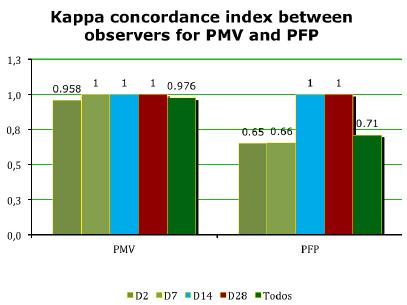PURPOSE
The parotidectomy technique still has an elevated paresis and paralysis index, lowering patient life's quality. The correct identification of the facial nerve can prevent nerve damage. Fluorescent dye identifies nerves in experimental studies but only few articles focused its use on facial nerve study in parotidectomies. We aimed to stain the rat facial nerve with fluorescent dye to facilitate visualization and dissection in order to prevent injuries.
METHODS
Forty adult male Wistar rats were submitted to facial injection of saline solution (Gsf-control group, 10) or fluorescent dye solution (Gdye group, 30) followed by parotidectomy preserving the facial nerve, measuring the time for localization and facility of localization (LocTime and LFN). Nerve function was assessed using the Vibrissae Movements (PMV) and Eyelid Closure Motion (PFP) scores.
RESULTS
Nerve localization was faster in Gdye group, with 83% Easy LFN rate. The Gdye group presented with low nerve injury degree and better PMV and PFP scores, with high sensitivity and accuracy.
CONCLUSIONS
This experimental method of facial nerve fluorescence was effective for intraoperative nerve visualization, identification and preservation. The technique may be used in future facial nerve studies, translated to humans, contributing to the optimization of parotid surgery in the near future.
Facial Nerve; Fluorescent Dyes; Parotid Gland; Rats







 Y-axis: LocTime: localization time of the facial nerve in minutes. Bars represent the different groups, Gcor: Fluorescent dye group, Gsem: Group without dye. p=0.001.
Y-axis: LocTime: localization time of the facial nerve in minutes. Bars represent the different groups, Gcor: Fluorescent dye group, Gsem: Group without dye. p=0.001.
 Y-axis: mean PFL scores, LFN: Score for the localization of the facial nerve, LocTime: Localization Time of the facial nerve, Gdye: Fluorescent dye group, Gsf: Group without dye, Both: Both groups.
Y-axis: mean PFL scores, LFN: Score for the localization of the facial nerve, LocTime: Localization Time of the facial nerve, Gdye: Fluorescent dye group, Gsf: Group without dye, Both: Both groups.
 Y-axis: Kappa concordance index, PMV: Vibrissae movement score, PFP: Eyelid closure score
Y-axis: Kappa concordance index, PMV: Vibrissae movement score, PFP: Eyelid closure score
 Y-axis: Total score of PMV, X-axis: Gdye and Gsf groups, PMV: Vibrissae movement score, Gdye: Fluorescent dye group, Gsf: Group without dye.
Y-axis: Total score of PMV, X-axis: Gdye and Gsf groups, PMV: Vibrissae movement score, Gdye: Fluorescent dye group, Gsf: Group without dye.
 Y-axis: Total score of PFP, X-axis: Gdye and Gsf groups, PFP: Eyelid closure score, Gdye: Fluorescent dye group, Gsf: Group without dye.
Y-axis: Total score of PFP, X-axis: Gdye and Gsf groups, PFP: Eyelid closure score, Gdye: Fluorescent dye group, Gsf: Group without dye.
 Y-axis: Total score of PMV, X-axis: Observation Time (days), PMV: Vibrissae movement score, D0-D28: Observation time in days, Gdye: Fluorescent dye group, Gsf: Group without dye.
Y-axis: Total score of PMV, X-axis: Observation Time (days), PMV: Vibrissae movement score, D0-D28: Observation time in days, Gdye: Fluorescent dye group, Gsf: Group without dye.
 Y-axis: Total score of PFP, X-axis: Observation Time (days), PFP: Eyelid closure score, D0-D28: Time points in days, Gdye: Fluorescent dye group, Gsf: Group without dye.
Y-axis: Total score of PFP, X-axis: Observation Time (days), PFP: Eyelid closure score, D0-D28: Time points in days, Gdye: Fluorescent dye group, Gsf: Group without dye.